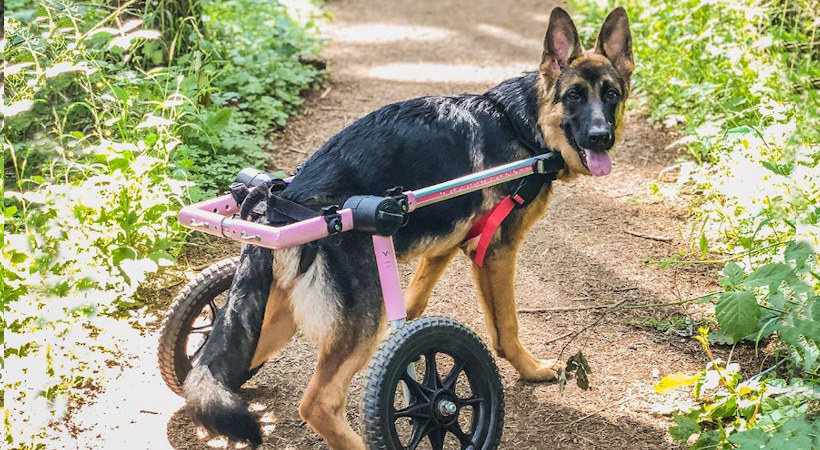
Is your dog dragging its back paws? Or starting to wobble? Here’s a quick primer on understanding Degenerative Myelopathy (DM) and what you might do to assist your dog.
Quick Facts About DM
Which Breeds Get It?
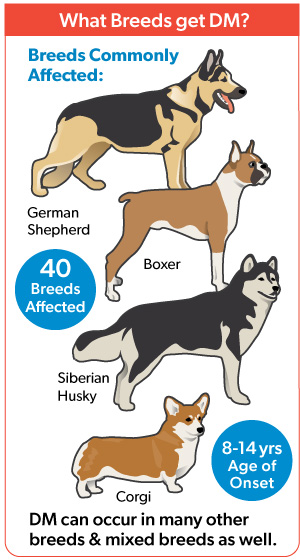
Degenerative Myelopathy is a progressive spinal disease affecting older dogs, usually between the ages of 4 to 14. Resulting in:
- Lack of coordination and swaying back legs
- Dog falls over if gently nudged from the side
- Paw knuckling and dragging
- Mobility loss with progressive worsening over time
As the condition progresses and the spinal cord deteriorates dogs will experience eventual paralysis.
Degenerative Myelopathy is a hereditary disease that passes down through bad breeding. DM is most prevalent in German Shepherds, but also occurs in Boxers, Siberian Husky, and Corgis. Degenerative myelopathy is the leading cause of hind leg weakness in German Shepherds.
DNA Testing for Degenerative Myelopathy
DNA testing is available to determine if your dog is at risk of developing or carrying the genetic mutation that causes Degenerative Myelopathy. A degenerative myelopathy test determines whether your dog is clear of the gene, if they are a carrier for the gene mutation, and if they are considered high risk for developing the condition when they’re older. Breeds at-risk for the condition should be tested prior to breeding to prevent DM from spreading.
Can Young Dogs Get Degenerative Myelopathy?
Younger dogs can be affected by degenerative myelopathy, but it is rare. DM is usually diagnosed in older dogs between the ages of 8 – 14 years old. The average age of DM onset is around age 9.
What Are the Symptoms of Degenerative Myelopathy?
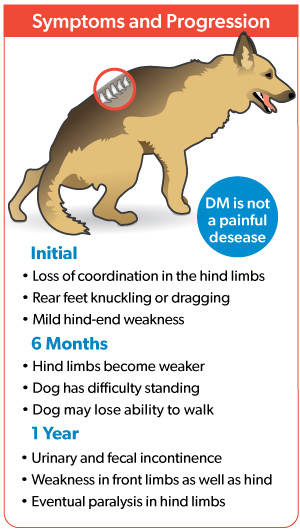
Symptoms of Degenerative Myelopathy will change and worsen over time. As a progressive condition, you can expect a dog with DM to experience significant changes in mobility as time goes on. The key to understanding DM, is knowing the different stages of mobility loss your dog will experience.
Early signs of DM include:
- Loss of coordination in the hind limbs
- Rear feet knuckling and dragging
- Mild hind-end weakness
Symptoms at 6 Months:
- Hind limbs become weaker
- Dog has difficulty standing
- Dog may lose ability to walk
DM Symptoms at 1 Year:
- Urinary and fecal incontinence
- Weakness in front limbs as well as rear
- Eventual paralysis in hind limbs
Understanding the stages and progression of degenerative myelopathy is crucial to determine the future mobility needs of your dog. DM doesn’t follow a strict timeline and the speed in which it progresses varies from dog to dog. Early signs of degenerative myelopathy are easy to miss, but the signs of mobility change soon become apparent.
Is Canine Degenerative Myelopathy Painful?
Dogs with degenerative myelopathy are not in any pain. Although DM itself is not a painful condition, as dogs grow weaker they do place additional stress on other parts of their body which can cause pain. As the hind legs weaken, a dog may experience pain in their shoulders, elbows, and front legs as they bear more weight on their front legs to compensate. DM dogs that are showing signs of pain, may be experiencing pain from another health condition such as arthritis.
How Do You Slow the Progression of Degenerative Myelopathy?
Degenerative Myelopathy progresses at a different pace for every dog. Some dogs will experience a rapid decline; others will slowly lose control of their legs over the course of months. Although we have little control over how fast DM progresses, recent studies have shown that exercise can slow the spread of Degenerative Myelopathy. For the best results, rehab therapy is best to give your dog regular, structured exercise that is tailor-made for their individual needs.
What Can I Do If My Dog Has DM?
There is no cure for canine degenerative myelopathy. Although there is no treatment for DM, there are many different ways to aid and support your dog as their condition progresses. Physical exercise is the key component to extending your dog’s life and slowing the progression of degenerative myelopathy. Here are a few ways you can improve your dog’s quality of life:
Assistive Equipment to Support DM Dogs
Your dog’s mobility needs will change throughout the many stages of DM. Here are a few assistive devices to help keep your dog moving.
- Slings and harnesses for a lifting support
- Pet boots to protect dragging paws
- Utilize training tools to help with paw placement and gait training
Holistic Care and Physiotherapy for Degenerative Myelopathy
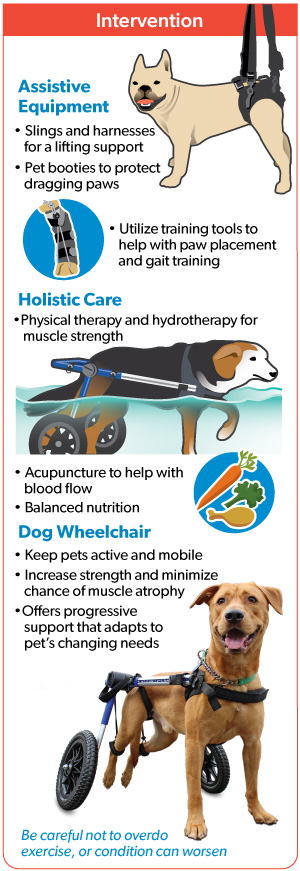
Work with your Vet and rehab specialist to come up with a treatment plan that includes a multi modal plan. Physical therapy is important for dogs with degenerative myelopathy, the benefits include: improved mobility, slowing down DM progression, and improve overall strength.
- Physical therapy and hydrotherapy for increased muscle strength
- Massage and acupuncture to help with blood flow
- Laser therapy to stimulate the nervous system
- Balanced nutrition
Combine natural treatments for degenerative myelopathy with rehabilitative exercise to promote overall physical health. Regular rehab sessions with a Certified Canine Rehabilitation Specialist helps to slow down DM progression. Its crucial to follow your CCRP’s exercise guidelines. Over exercising a dog with degenerative myelopathy can lead to muscle fatigue and exhaustion.
Dog Wheelchairs for Degenerative Myelopathy
Eventually every dog diagnosed with Degenerative Myelopathy will need the support of dog wheelchair. Paralysis is the hallmark of DM and your dog will require a mobility cart to stay active. Here are a few of the ways a dog wheelchair can support your dog:
- Keep pets active and mobile
- Increase strength and lower the chance of muscle atrophy
- Offers progressive support that adapts to a pet’s changing needs
- Enhance degenerative myelopathy rehabilitation sessions with wheelchair support
- Aid dogs with DM with balance struggles
- Dog wheelchairs promote mental wellbeing and lower risk of a dog becoming depressed from inactivity
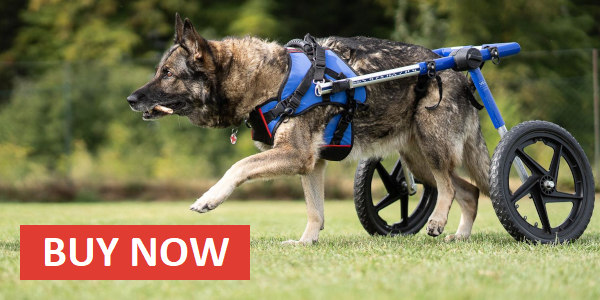
*All credits for this article go to Walkin’ Pets where the original article can be found*



